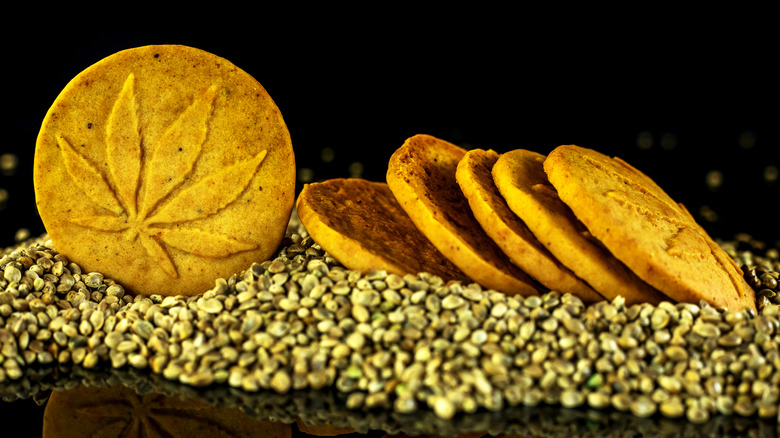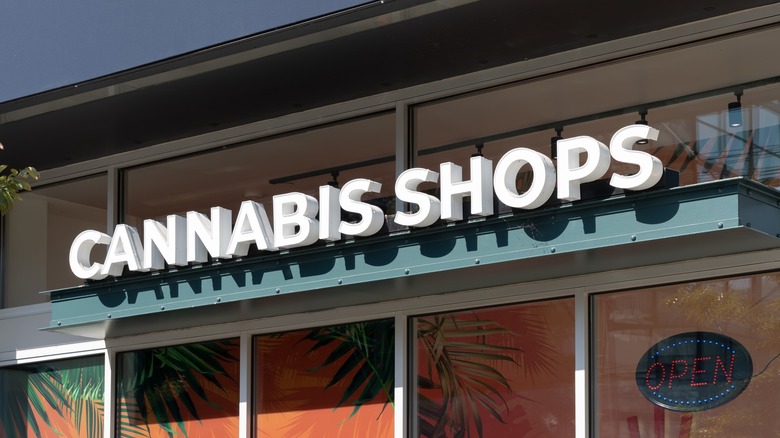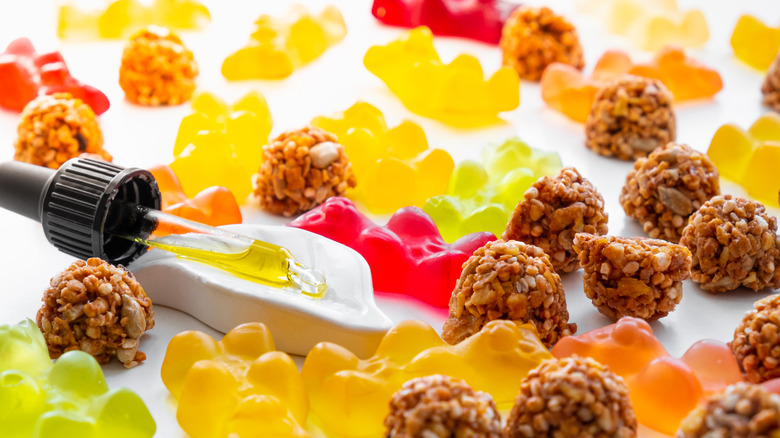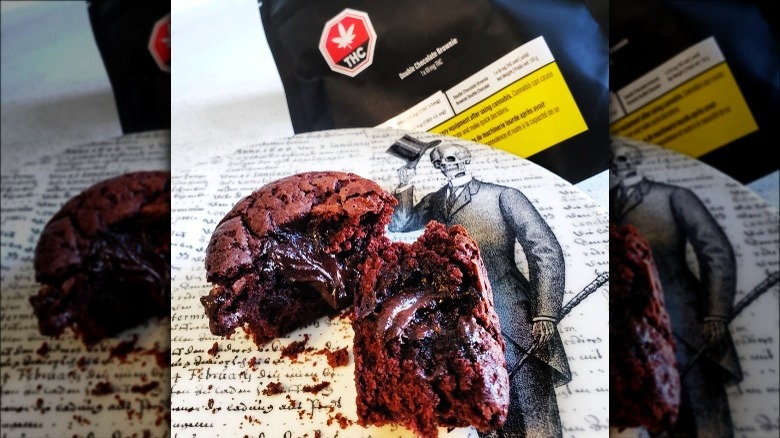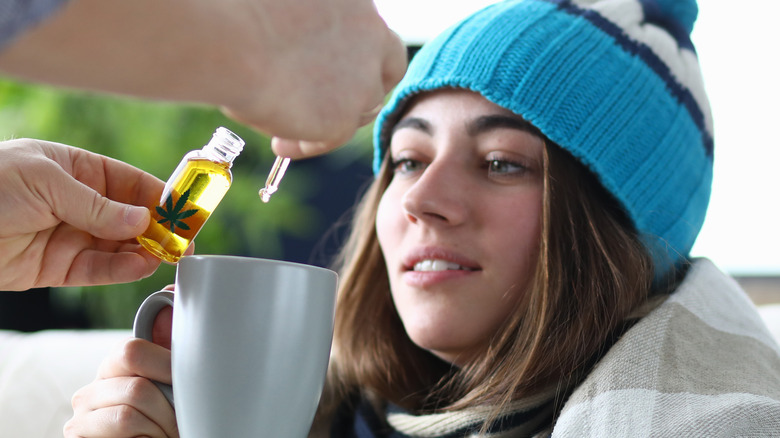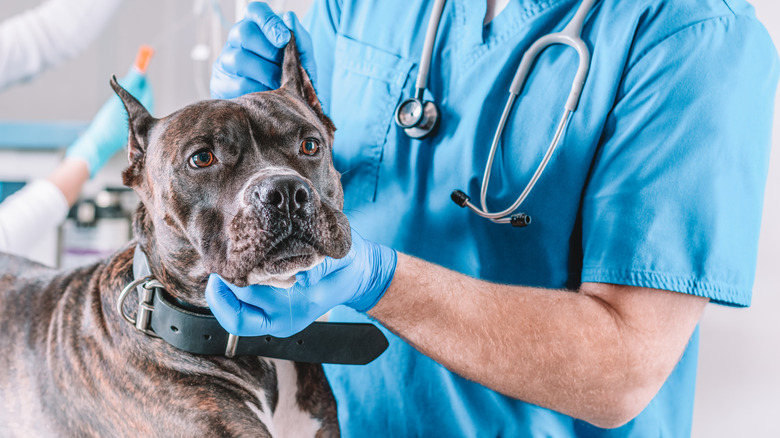What You Need To Know About Marijuana Edibles
The war on drugs may be a lost cause, but a cannabis revolution is sweeping the U.S. After Colorado and Washington state legalized recreational marijuana in 2012, 16 other states and the District of Columbia have followed their lead, according to U.S. News & World Report. Seventeen states that don't allow the sale of recreational marijuana allow THC (marijuana's active ingredient) for medical purposes, per ProCon.org and O.Berk. So, chances are, if you're an American reading this you have some access to legal, mind-altering cannabis.
Many people associate "getting baked" with either smoking the marijuana plant or quite literally doing some baking by popping pot brownies in the oven. But there's a whole wide world of marijuana edibles out there that extends far beyond any enhancements Snoop Dogg might wish to add to Martha Stewart's brownie recipe (via MarthaStewart.com).
Edibles are a growing fraction of the legal pot business in the U.S., according to The Washington Post. The Specialty Food Association declared marijuana edibles to be a 2018 food trend of the year. Edibles rank third in cannabis sales, behind the smokable flower and vape products.
Ingesting edibles brings risks that are unique to the product. It can take an hour or an hour and a half to feel an edible's effects, so some people may be tempted to up their dose because they aren't feeling anything right away (via Lifehacker). This can result in a high that's higher than they bargained for — even to the point of a "psychotic episode," a doctor told The New York Times.
Where is it legal to consume marijuana edibles?
If you're thinking about giving marijuana edibles a try but want to stay on the right side of the law, then these lists might help. As of 2021, recreational marijuana is legal in the following 18 states, listed from first to legalize it to most recent (via U.S. News & World Report): Colorado, Washington, Alaska, Oregon, California, Maine, Massachusetts, Nevada, Michigan, Vermont, Illinois, Arizona, Montana, New Jersey, New York, Virginia, New Mexico, and Connecticut. If you're in Guam or the District of Columbia, you're good, too.
These 17 states, going roughly west to east, allow medical marijuana but not recreational, according to ProCon.org and O.Berk: Hawaii, Utah, North Dakota, South Dakota, Minnesota, Oklahoma, Missouri, Arkansas, Louisiana, Florida, Ohio, Pennsylvania, West Virginia, Maryland, Delaware, New Hampshire, and Rhode Island.
These quick lists should not be read as a simple "okay or not okay" situation. For example, edibles aren't allowed in the medical marijuana state of Maryland. The Washington Post reports that edibles are also banned in North Dakota, and the only things remotely edible allowed in Pennsylvania are pills, oils, tinctures, and other liquids. DUI laws generally apply to marijuana use, too. Check your own state's regulations as they pertain to cannabis in general and edibles in particular.
What kinds of food are used to make edibles?
Store-bought marijuana edibles aren't going to bowl anyone over ... not with their culinary refinement, in any case. They're generally of the pre-packaged snack food and candy variety. You can find cookies, brownies, lollipops, chocolates, and gummies (via Denver Health). Some shops carry Altoid-like mints and hard candies containing THC, according to Verilife. For those who might want to spice up their own home cooking, cannabis dispensaries offer THC-infused cooking oil. People who prefer savory to sweet can look for the more offbeat bison jerky (via Lifehacker).
Candy lozenges, THC-infused beverages, tinctures, and dissolving strips similar to mouthwash products can be ingested sublingually, which produces a different effect, according to a separate Verilife webpage. Sublingual THC — or doses meant to be absorbed under the tongue — kick in faster (about 15 minutes instead of the usual 60-90 minutes) and aren't as intense as edibles that are absorbed through digestion.
Several states, including California and Colorado, consider a single-serving edible to contain 10 milligrams of THC, according to District Edibles. The suggested starting dose for first-timers is 5 mg; you can add to that after two hours if you aren't getting a satisfying psychoactive effect. District Edibles' dosage scale goes all the way up to 100 mg, or 10 pieces of candy in certain states. This dosage is recommended only for people with high THC tolerance and can come with unwanted side effects, including rapid heart rate and nausea.
What happens when you eat too many marijuana edibles?
New York Times columnist Maureen Dowd famously gave voice in 2014 to the concerns of buttoned-up America when she wrote about her nightmare first-time experience with a marijuana edible. Legal marijuana was still new, and Dowd was in Colorado to do what any gonzo journalist would do: report on something by experiencing it first hand. It didn't go well for Dowd. She ate a small portion of her THC chocolate bar, but it was still much too much for a beginner, and what information there was on the package hadn't made that clear. She curled up in a ball on her hotel room bed, fearing the room-service guy was going to have her arrested when he showed up with dinner. Other stories of excessive THC consumption were much, much worse, including one Dowd told of a husband and father of three who got so paranoid he shot and killed his wife. She was on the phone with a 911 dispatcher because he was behaving so erratically.
The typical response to these incidents among cannabis advocates is that people inexperienced with edibles should read the label first. To be extremely safe, start with just a 2.5 mg dose (via The Atlantic). However, a study of label accuracy published in 2015 and reported in a New York Times article concluded that only 17 percent of edibles tested were dosed properly. Most had less THC than the packaging indicated, but some had more.
What are the health benefits and risks of edibles?
Therapists report clients are increasingly ditching their antidepressant pills for products that contain THC, to relieve anxiety, depression, and insomnia, according to The Wall Street Journal. But the body of research on marijuana's effectiveness as a treatment for mental disorders is inconclusive and incomplete. Some studies suggest that marijuana helps reduce anxiety and insomnia, but the American Psychiatric Association put out a statement in 2019 saying cannabis can do more psychiatric harm than good. The drug has proven itself as a treatment for seizures, weight loss in AIDS patients, and nausea in people undergoing cancer treatment, and it has federal approval for these uses.
While smoking marijuana may be linked to certain types of cancer and inflammation of the respiratory system, edibles have not been shown to harm the lungs or increase cancer risk (via Healthline).
A 2020 study in the Journal of Clinical Medicine said edibles are dangerous because they are unpredictable. You never know how much ingested THC will make it to a person's bloodstream. The journal article went on to say that because the euphoric effects of THC take longer to kick in when you eat it, people sometimes overconsume, which can increase the risk of certain health complications. There is some evidence that connects edible marijuana to heart attacks.
Edibles may be more potent than smoked marijuana, according to The Atlantic. Some scientists say the 11-hydroxy THC your body produces in the liver after eating marijuana is more potent than the delta-9 THC that hits your brain when you smoke it.
What happens when dogs or children eat edibles by mistake?
With all the horror stories — either real or the product of an intoxicated imagination — associated with edible overconsumption, the bottom line is this: Informed adults should be able to use edibles safely. Unfortunately, the same cannot be said for children or pets. To pick on just one state, cases of canine intoxication in Colorado increased elevenfold since marijuana was legalized there in 2012, according to the Los Angeles Times. Dogs are coming across their owners' stash in the house, or else they're consuming discarded edibles while on walks at public parks or on school grounds. Stoned dogs appear depressed and unsteady on their feet. Veterinarians say an owner who suspects cannabis poisoning in their dog should contact their vet immediately.
Marijuana legalization has also led to a huge increase in the numbers of children visiting the ER after eating what looked like ordinary candy but was in fact an adult's THC-laced edibles (via The Washington Post). In the early days of legal pot, edibles were packaged to mimic real candy with names such as Stoner Patch Dummies and Reefers Cup. More recently, the packaging has been changed to be childproof and to more clearly indicate it contains THC.
A high dose of THC generally won't be fatal for even a young child or a dog, and the number of ER visits from ingesting cleaning or other household poisons is much higher. Nevertheless, common sense should prevail: If you have edibles in a space children or pets might enter, then keep them out of reach.
